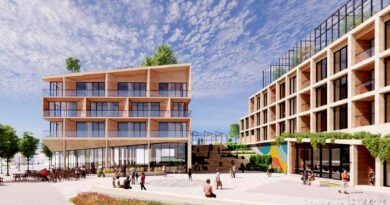Major Development On Horizon
By John Swartz
The City of Orillia’s Downtown Tomorrow Plan is turning out to be one of those navel gazing exercises that is not gathering dust on a shelf, specifically with the initiative to reconstruct Front Street and Centennial Drive and package the 70 Front Street project so it is attractive to developers, because at Monday night’s committee meeting the details of two new major developments were on the agenda.
The Sterling Group plans to build 53 townhouses on the former Schacter land opposite Veteran’s Park, and a doctor’s group wants to buy the former Goodwilll Store on King Street at West and redevelop it as an outpatient medical center.
It’s a case of those specific projects and 70 Front Street affecting each other said Richard Bertolo, director of the economic development department.
“This one (Sterling) is going to be looked at by all the proponents bidding on 70 Front Street, said Bertolo. “We find this one to be of utmost importance. It is the first one to take on the challenges of that area.”
By challenges, Bertolo means it is a brown field site, as is the Goodwill site. Developers are reluctant to take on projects on former brown field sites because of added costs, and the possibility of not knowing everything about the site before ground is broken – which can delay and drive up costs even more.
What is a City to do to get underused, or eyesore properties redeveloped if developers pass over them? The province allowed vehicles called community improvement plans municipalities can use in a variety of ways to provide financial incentives, tax relief. The Downtown Tomorrow Community Improvement Plan (DTCIP) covers most of the central core and there are 8 components the City can apply. Five of those have already been used for small projects, but the two in question Monday night are each in the millions of dollars.
The three parts not used yet (council’s decision has to be ratified next Monday night), involve grants for development charges, property tax relief and brown field clean up. In the case of Sterling, their grant proposal is for brown field clean up, and the doctor’s project, called NABI Inc., is for property tax relief.
“We want to see a project where the impact is not only on that property, but it has a greater impact on surrounding properties,” the economic department’s Laura Thompson told SUNonline. Both projects were described as catalytic, meaning the intent is to support certain projects that should galvanize other property owners to redevelop their properties.

“This project, I think, is a representation of why we originally contemplated the upper tiers of the community improvement program. This particular project will certainly increase the assessment value of that property,” mayor Steve Clarke said of the Sterling development. The other project has the same expectation.
“The City will realize a return on investment and get this money back within a small number of years, and of course, realize that positive cash flow in perpetuity,” said Clarke.
It’s tricky to follow along with what is happening, and there are those who see this as giving money to developers, however closer examination reveals it’s actually a case of the City recognizing the value of property taxes they would not otherwise get if properties remained undeveloped.
“The Municipal Act prevents us from bonusing, for example by giving money. Only though the Community Improvement Plan can you grant funds to specific development,” said Thompson.
In the case of the NABI project, they still pay their property taxes, and with the assessment estimated to increase by $2.5 million, the City will collect 100% of the annual tax bill, but set aside for return a portion, if the developer meets a number of conditions, chiefly they start building this year.
“Approximately 70% of the tax increase would have a value of approximately $55,000. The City would still get that increased assessment of 30%,” said Thompson. The total amount of a grant, spread over 5 years, is $250,000.
In the Sterling case, their grant (up to $200,000) is for development charges, provided they start this year, and it equals the amount of money Sterling will spend on remediation. The increased assessment is expected to be $3 million. Basically the City is moving money from one account into the development charges reserve account because development charges must be paid by someone. Again, those are funds the City wouldn’t get if no development takes place.
“Up to 100% of the development charges to be paid will be initially deferred with a grant to be paid by the City into its development charges reserve fund on behalf of the applicant at the end of the deferral period – only once they’ve met all the requirements of the grant,” said Thompson.
Staff identified 5 properties eligible for tier 3 grants including those owned by Circoflex on Barrie Road, the Matchedash Lofts project, and the Building Hope project. Only the two presented were pursued by developers. All 5 were considered because staff viewed them as catalyst projects.
“We want to see a project where the impact is not only on that property, but it has a greater impact on surrounding properties,” said Thompson.
Development activity tends to get attention by other property owners who may also decided to create something where nothing exists, or spruce up their properties to varying degrees ranging from a major renovation to a coat of paint. There have been several recipients of smaller grants from the other 5 parts of the CIP the City activated.
“What we are hearing from applicants, 90% have said the grant has allowed them to go either bigger or faster than they otherwise could have. For example, Refillery District was able to add an accessible door because of the grant,” said Thompson.
Faster is the operative word in Sterling’s case. The company said they can’t start selling units until the site is cleaned up, and banks won’t finance until a majority of units are sold. Sterling is reluctant to start selling in case their plans have to be modified because of remediation. The company estimates receiving a grant will chop many months off the timeline to occupancy of housing units.
“One of the reasons we felt the Sterling Group’s proposal was catalytic is because the impact of the grant would be that the project would accelerate by 10 months. The intent of this grant program is not just to give grants to offset developer’s fees. The intent is to have an impact on the project, make it happen faster,” said Thompson.
NABI Inc. is also looking at a property outside City limits, but Thompson said she understand they have a conditional offer on the King Street property.

There are other vacant lands near the King/ West intersection and the City believes those property owners will take note of the commitment by both the City and the developer and see the time is now to get moving on their projects.
“Staff believes that the investment of over $3 million at 4 King Street will further demonstrate that the West Street corridor is being revitalized and is an area that is prime for investment,” said Thompson. The same sentiment was expressed during the council meeting regarding the Sterling project.
Along with the recommendations for grants, staff asked for $20,000 to cover legal fees. Councilor Rob Kloostra questioned why when developers normally pay fees, including legal.
“In this case we recommending the City pay those costs because when we draft these agreements we’re going to ask they be drafted in such a way they can be used as a template for future reports,” Thompson told council.
They expect a lawyer’s work drafting a template will account for other areas of concern for the three components of the DTCIP to create a menu of all possible situations that may apply which staff can then plug into specific property/grants for the next applicants with only minor tweaking paid for by applicants.
The bottom line is Orillia will soon be buzzing with development activity in the core, and just like in the restaurant business, people drive right by an empty parking lot while a full parking lot lures more patrons.
(Photos by Swartz – SUNonline/Orillia) Workers testing soil at the Sterling Group (Shacter) development site opposite Veteran’s Park.




